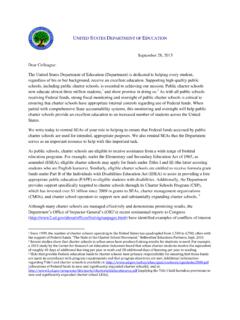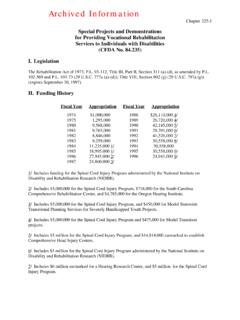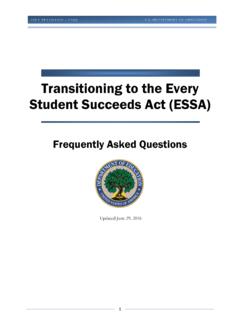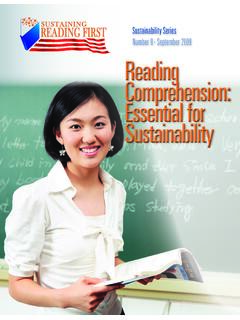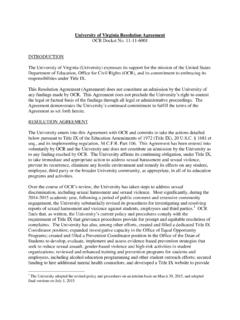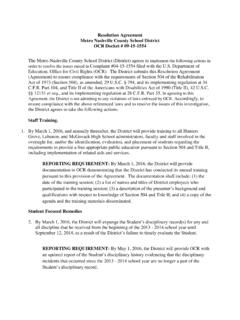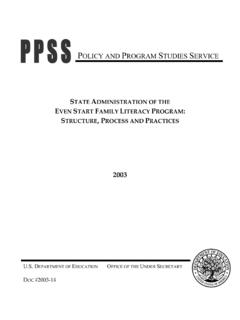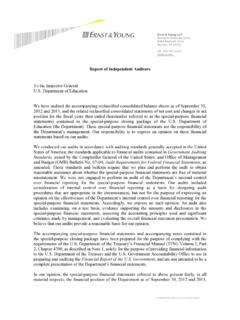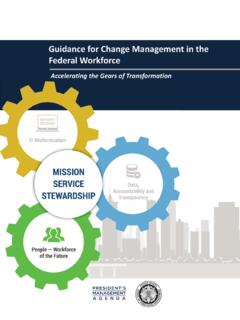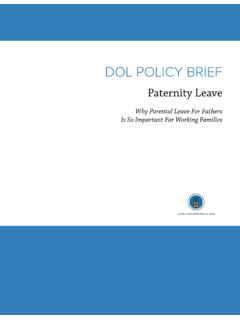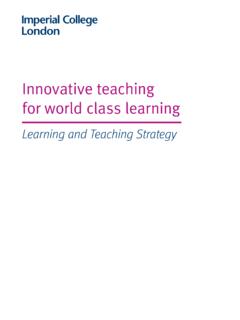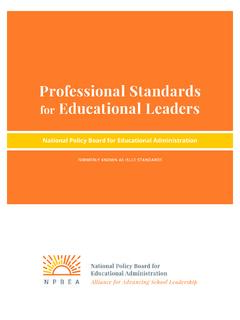Transcription of ED COVID-19 Handbook, Volume 2 (PDF)
1 OPEPD-IO-21-02. Volume 2 2021. ED COVID-19 . HANDBOOK. Roadmap to Reopening Safely and Meeting All Students' Needs Volume 2. Roadmap to Reopening Safely and Meeting All Students' Needs 2021. i Department of Education Dr. Miguel A. Cardona Secretary of Education Office of Planning, Evaluation and Policy Development Donna M. Harris-Aikens Acting Assistant Secretary Initially released in April 2021; updated August 2021. The updates included in this Volume of the ED COVID-19 Handbook are based on the most recent Centers for Disease Control (CDC) guidance issued as of August 17, 2021. For the most recent CDC guidance issued after the release of this Volume and how to consider the strategies included in this resource within the context of the most up to date guidance please visit: Summary of Recent Changes in August 2021 Update: Revised guidance related to physical health and safety to align with updates to CDC.
2 Guidance as of the time of the release. For the most recent CDC guidance, please visit: This report is in the public domain. Authorization to reproduce it in whole or in part is granted. While permission to reprint this publication is not necessary, the citation should be Department of Education, Office of Planning, Evaluation and Policy Development, ED COVID-19 Handbook, Volume 2: Roadmap to Reopening Safely and Meeting All Students' Needs Washington, DC, 2021. This report is available on the Department's website at Availability of Alternate Formats On request, this publication is available in alternate formats, such as Braille or large print. For more information, please contact the Department's Alternate Format Center at 202-260-0818 or via e-mail at Notice to Limited English Proficient Persons If you have difficulty understanding English, you may request language assistance services for Department information that is available to the public.
3 These language assistance services are available free of charge. If you need more information about interpretation or translation services, please call 1-800-USA-LEARN (1-800-872-5327) (TTY: 1-800-877-8339), email us at or write to Department of Education, Information Resource Center, 400. Maryland Ave., SW, Washington, DC 20202. ii Contents Introduction.. 1. I. Creating Safe and Healthy Learning Environments.. 5. a. Meeting basic needs: providing school meals regardless of educational setting .. 5. b. Meeting the social, emotional, and mental health needs of students.. 8. c. Providing all students with access to a safe and inclusive learning environment.. 12. II. Addressing Lost Instructional Time.. 18. a. accelerating learning through instructional approaches, tutoring, and expanded learning time.
4 18. b. Supporting equitable access and effective use of technology.. 25. c. Using data about students' opportunity to learn to help target resources and support.. 28. d. Addressing resource inequities.. 32. III. Supporting Educator and Staff Stability and Well-Being .. 38. a. Stabilizing a diverse and qualified educator workforce .. 38. b. Supporting educator and staff well-being .. 42. iii Introduction Coronavirus Disease 2019 ( COVID-19 ) has exacerbated existing inequities and inadequacies across a range of social structures, including our nation's education system. The pandemic has also had a more damaging impact on communities and people of color, including many who already faced health challenges. Congress has provided significant federal funding, including most recently through the historic American Rescue Plan Act of 2021 (ARP), to support the safe reopening of schools.
5 However, this is the first of many steps ahead. For most schools, returning to the status quo will not address the full impact of COVID-19 on students' social, emotional, physical, mental health, and academic needs or the impact on educator and staff well-being. Approaches to school reopening must be designed in ways that meet the needs of students, educators, and staff. President Joe Biden has called on us all to consider how we can build back better. Just as we continue to look to the evolving science as we work to reopen schools safely, so too should we turn to research and evidence, as well as the voices of students, educators, staff, and their families, to inform efforts to address the social, emotional, mental health, and academic impact of COVID-19 . With the passage of ARP, states, districts, and schools now have significant federal resources available to implement evidence-based and practitioner-informed strategies to meet the needs of students related to COVID-19 , including students most affected by the pandemic and for whom the pandemic exacerbated pre- existing inequities.
6 This guidance document is intended to be a resource for states, districts, schools, and teachers as they reopen schools safely and support students. Separately, the Department will issue guidance on specific provisions of ARP statute and program implementation. Specifically, funding under ARP can be used to: Implement COVID-19 prevention strategies to safely reopen schools and maximize in-person instruction and that align with public health guidance, including upgrading school facilities for healthy learning environments;. Address the impact of lost instructional time by supporting the implementation of evidence-based interventions that respond to students' social, emotional, and academic needs;. Address the disproportionate impact of COVID-19 on students of color, students from low-income backgrounds, students with disabilities, English learners, students who are migratory, students experiencing homelessness, students in correctional facilities, and students in foster care.
7 Provide afterschool, or other out-of-school time, programs that address students' social, emotional, and academic needs;. Address the mental health needs of students, including through using funds to hire counselors and other staff;. Provide integrated student supports, including through the use of full-service community schools;. Provide students with evidence-based summer learning and enrichment programs, including through partnerships with community-based organizations;. Connect K-12 students to high-quality home internet and/or devices;. Stabilize and diversify the educator workforce and rebuild the educator pipeline;. 1. Provide children and youth experiencing homelessness with integrated student support services and assistance with attending school/participating in activities; and Provide for any activities allowed under the Elementary and Secondary Education Act of 1965, as amended (ESEA), the Strengthening Career and Technical Education for the 21st Century Act (Perkins V), and the Individuals with Disabilities Education Act (IDEA).
8 These funds also provide an opportunity to address the most urgent needs of students, teachers, and staff while making the kinds of investments that build state, district, and school capacity in ways that sustain meaningful and effective teaching and learning. If well-invested, funding through ARP can help address gaps in educational opportunity and outcomes not just during the COVID-19 pandemic, but beyond. As stated in Executive Order 14000, Supporting the Reopening and Continuing Operation of Schools and Early Childhood Education Providers, every student in America deserves a high-quality education in a safe environment. The Biden-Harris Administration (Administration) believes strongly that returning to in-person learning as soon as possible is essential for all students and families.
9 This is why the Administration moved quickly to release Volume 1: strategies for Safely Reopening Elementary and Secondary Schools of this COVID-19 Handbook to aid educators in implementing the Centers for Disease Control and Prevention (CDC). Operational Strategy for K-12 Schools through Phased Prevention (K-12 Operational Strategy) by addressing common challenges and providing practical examples. As stated in Volume 1, the Administration acknowledges the unique impact of COVID-19 on, and trauma experienced by, underserved students, including students from low-income backgrounds, students of color, lesbian, gay, bisexual, transgender, and queer (LGBTQ+) students, English learners, students with disabilities, migratory students, rural students, American Indian, Alaska Native, Native Hawaiian, and Asian American Pacific Islander students, students in foster care, students in correctional facilities, and students experiencing homelessness.
10 The Administration recognizes that communities of color have borne a disproportionate burden of illness and serious outcomes from COVID-19 and require additional considerations. Volume 2: Roadmap to Reopening Safely and Meeting All Students' Needs is intended to offer initial strategies for providing equitable and adequate educational opportunities that address the impact of COVID-19 on students, educators, and staff, focusing on evidence-based strategies for: Meeting students' social, emotional, mental and physical health, and academic needs, including through meeting basic student needs; reengaging students; and providing access to a safe and inclusive learning environment;. Addressing the impact of COVID-19 on students' opportunity to learn, including closing the digital divide; implementing strategies for accelerating learning; effectively using data; and addressing resource inequities; and Supporting educator and staff well-being and stability, including stabilizing a diverse and qualified educator workforce.
